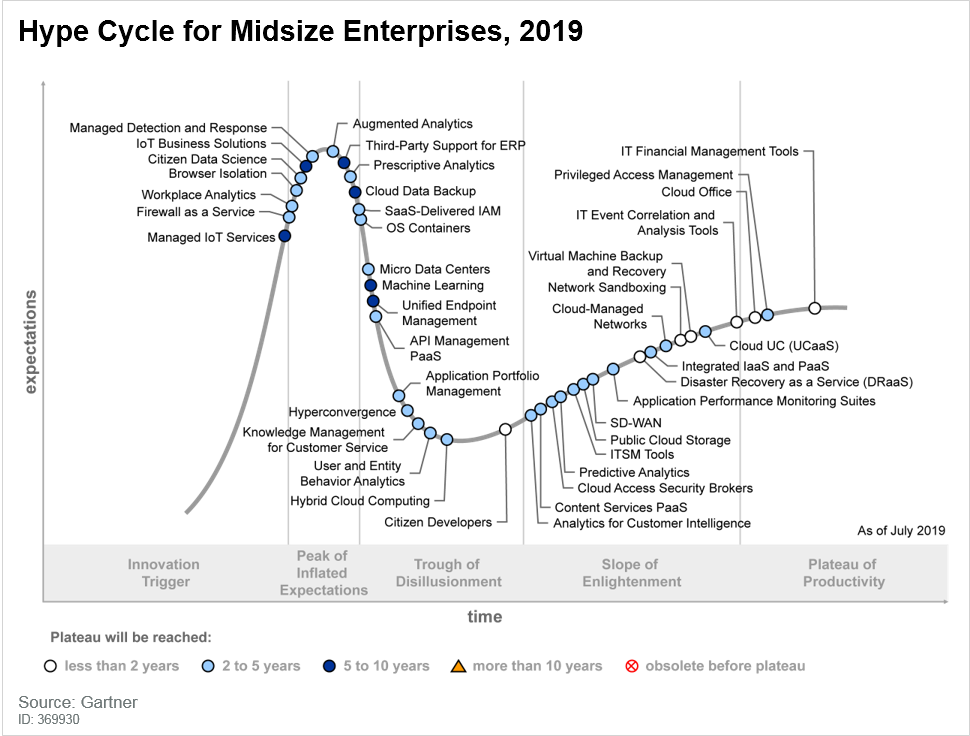
Cloud. Machine learning. Edge computing. Internet of Things (IoT). The reality of being a CIO is dealing with the constant influx of new, shiny technologies.
About 68% of midsize CIOs expect to increase investment in information technology in 2019 over 2018, according to the 2019 Gartner and Senior Business Executive Survey. Obviously CIOs can’t — and shouldn’t — invest in every opportunity, but some technologies could have wide-ranging impact and amplify business capabilities. It is key that these CIOs prioritize high-impact investments.
“This Hype Cycle is intended to help midsize enterprise (MSE) CIOs develop effective strategies, deliver roadmaps, and drive discussions with other executives and colleagues on how technology can improve, disrupt or create new opportunities within their organizations,” says Mike Cisek, VP Analyst, Gartner. “MSE CIOs must continually evolve and innovate to expand their role as proactive business partners.”
[swg_ad]The Gartner Hype Cycle for Midsize Enterprises, 2019 reflects three major trends:
- Data-driven culture: Delivering and supporting the infrastructure, business capabilities, and a culture that acts on data and data-driven insights (i.e., workplace analytics, citizen data scientists, augmented analytics, prescriptive analytics, analytics for customer intelligence)
- Risk-based security: A practical, cost-effective approach to protecting the areas of greatest risk, while avoiding overspending on security tools (i.e., firewall as a service, managed detection and response, unified endpoint management, user and entity behavior analytics, cloud access security brokers)
- Infrastructure utility: Easily managed, software-defined solutions supporting distributed workloads that securely transverse traditional on-premises and cloud-native architectures (i.e., hyperconvergence, virtual machine backup and recovery, integrated IaaS and PaaS, disaster recovery as a service, cloud UC)
The 40 technologies on this Hype Cycle include a disproportionate number with a benefit rating of “high.” MSE CIOs should focus on these high-ROI technologies and use rapid tests and proofs of concept to keep pace with changes.

Citizen developers
What is it? A citizen developer is an employee who creates new business applications for consumption, normally on their own but potentially with others, using development and runtime environments sanctioned (or at least not actively forbidden) by corporate IT or the enterprise line-of-business organizations.
Why does it matter? The reality of today’s IT is that often the timelines to build are too long to meet business needs. Resource constraints and shrinking budgets make a prompt response difficult. With the rise of cloud solutions and low-code applications, employees outside of IT can now operate outside of IT’s view. The goal is not to ban this type of development, but rather to create good citizen developers.
Embrace end-user development, but set clear boundaries that meet both IT and business needs and offer user-friendly, IT-sanctioned development platforms. This will allow businesses to meet their needs while offering a bit of oversight and control to IT. Finally, trust, but verify. Make sure citizen developers have IT guidance and a safe environment within which they can be innovative and creative.
Augmented analytics
What is it? Augmented analytics uses machine learning to automate data preparation, insight discovery, data science, and machine learning model development and insight sharing for a broad range of business users, operational workers and citizen data scientists.
Why does it matter? Increasingly sophisticated data in increasingly large amounts has made it challenging to manually draw insights. Users simply cannot explore every possible pattern or even determine which information is relevant and helpful. This may result in missing key data or focusing on the wrong insights.
As augmented analytics matures, it will become a key feature in modern analytics platforms and its insights will become part of enterprise applications across industries. As the technology matures, there will be reduced bias and more citizen data scientists. Gartner predicts that by 2020, due in large part to the automation of data science tasks, citizen data scientists will surpass data scientists in the amount of advanced analysis produced.
Citizen data science
What is it? Citizen data science is an emerging set of capabilities and practices that enable users to extract advanced analytic insights from data without the need for extensive data science expertise.
Why does it matter? The complex world of data traditionally required an expensive and hard-to-find data scientist with extensive expertise. However, the rise of modern analytics and citizen data science tools have reduced the threshold of necessary knowledge. These tools guide business users through the process and will automatically discover and share insights with the user.
Design a specific citizen data scientist role within the company and set clear boundaries for how that role fits within the larger analytics team. Ensure that education, governance and responsible use are a part of the rollout. Citizen data science is the foundation of next-generation analytics and can be used not only to fill the data scientist talent gap, but to allow data scientists to focus on more difficult analytics work and insight.
Micro data centers
What is it? A micro data center is modular or containerized and is smaller than a computer room — usually no more than a rack or two of equipment — and typically one rack or less. It contains all necessary technology and is designed to handle specific tasks at distributed locations, but is typically managed remotely from a large data center
Why does it matter? Not all IT needs to be centralized, though traditionally (and currently) small computer rooms are often absorbed into larger data centers. Micro data centers are often used when latency or site-specific issues demand it. These centers can be used almost anywhere and are increasing in popularity alongside distributed technologies like IoT and edge computing. Design micro centers to run autonomously, using a standard self-contained solution. Generally, these data centers rely on more mature IT and facilities technologies.
IoT business solutions
What is it? An IoT business solution is the combination of IoT technologies and business applications that produces desired outcomes such as asset optimization or product as a service.
Why does it matter? IoT business solutions are further out on the Hype Cycle with transformational value, but have five to 10 years until mainstream adoption. Currently, these projects are limited in scope and the value proposition isn’t yet fully understood. Although IoT solutions will initially appear as point solutions, they will create more value once they’ve been integrated with back-end systems and data to automate and optimize business response. Now is the time to explore their potential business value and focus on investing in one or two platforms to integrate over time.
The post 3 Major Trends Drive the Gartner Hype Cycle for Midsize Enterprises, 2019 appeared first on Smarter With Gartner.
read more at https://blogs.gartner.com/smarterwithgartner by Kasey Panetta
Business









